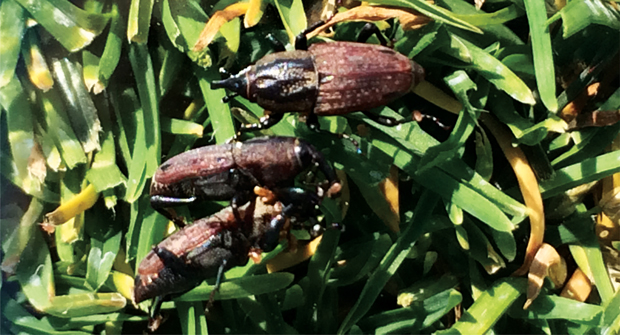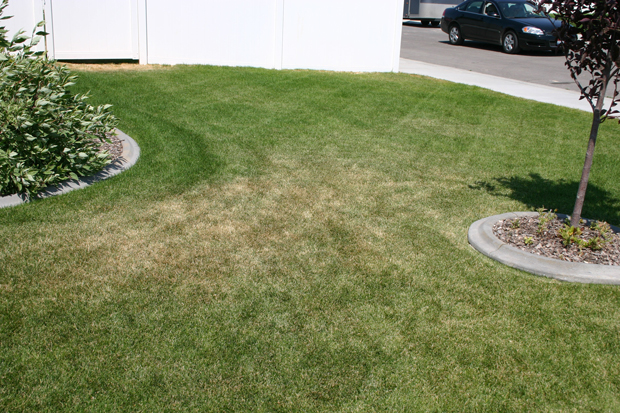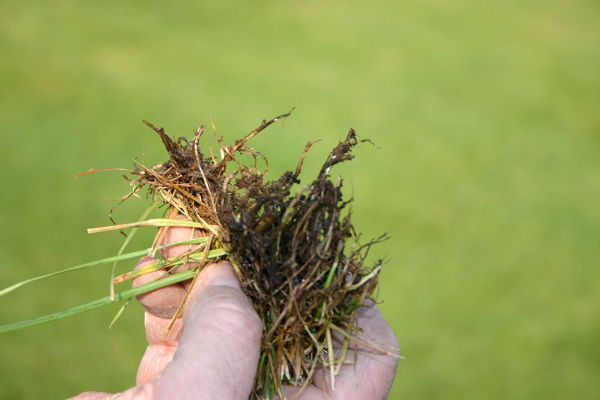

If you’re not concerned about insects in your clients’ lawns, think again. Billbugs are one of the most widespread and damaging insects for turfgrass. We asked Rick Fletcher, technical services manager, turf and ornamentals for Nufarm America, and Dean Mosdell, technical manager, western U.S., for Syngenta, to share some management advice.
Damage
If left untreated, billbugs can kill turfgrass. “Typically, on a lawn that’s been infested with billbugs, you’ll see what looks like drought damage,” Mosdell says.
To identify billbugs as the culprit, Mosdell and Fletcher both recommend the “tug test.” Fletcher says lawn care operators (LCOs) can also perform this test to check for white grubs.
“The easiest test is to grab the grass plant stem and tug it,” Fletcher explains. “In a billbug scenario, the stem breaks off right above the crown. And when you look closely at it, it looks hollowed out like a soda straw.”
When the larvae begin feeding on the turfgrass plant, it tunnels into the stem of the plant and causes a disruption to the plant’s vascular system, Fletcher says. “The top of the plant presents itself as if it’s wilting,” he says. “Then all of a sudden, the plant can’t get water, so it dies off and quits.”

Life cycle

Also known as snout beetles, billbugs are weevils and use their snout to probe turfgrass plants and lay eggs, according to Mosdell. Since billbugs overwinter, they are typically spring hatchers.
Billbugs’ feeding stage happens as larvae. As larvae get older, they tend to work deeper from the stem toward the root system.
“The most severe damage to turfgrass is primarily when they start feeding on the root system of the plant,” Mosdell says.
Billbug management
Billbugs aren’t going away. Actually, the problem is getting worse, according to Mosdell. Since billbugs only crawl to get to new areas, most of their distribution comes from moving turf around. This can be a problem with sod installations. Mosdell says LCOs should be diligent and inspect sod as soon as it arrives.
Diligent identification, maintaining healthy turf and control timing are keys to control. “If you have billbugs in an area and you didn’t do any type of treatment, billbugs are still in that area,” Fletcher warns.

Treating in early spring will knock down the billbug population before damage to the turfgrass begins. A preventive insecticide should be applied based on growing degree days and past research, Fletcher advises.
In the spring, LCOs should plan to knock down the adult population that overwintered and then treat systemically to get eggs before they hatch, Fletcher says.
Damage symptoms occur in the spring, even if not immediately visible. Once the damage is done, it’s time to plan for the following year.
Keeping a healthy stand of turf can mitigate damage. Mosdell recommends using varieties of turfgrass more resistant to billbugs. Some varieties, such as ryegrass and fescues, contain endophytes, which billbugs tend to not prefer for feeding.
“Once you have billbugs, there are really very few choices other than tolerating the injury and applying fertilizer and water,” Mosdell says.
For treating billbugs as eggs, Fletcher and Mosdell suggest using products with one of the following active ingredients: chlorantraniliprole, thiamethoxam, clothianidin, imidacloprid and dinotefuran. “Curative applications are less successful but can be made,” Mosdell says.
When treating billbugs as adults, consider using products with active ingredients such as cyhalothrin and bifenthrin.

